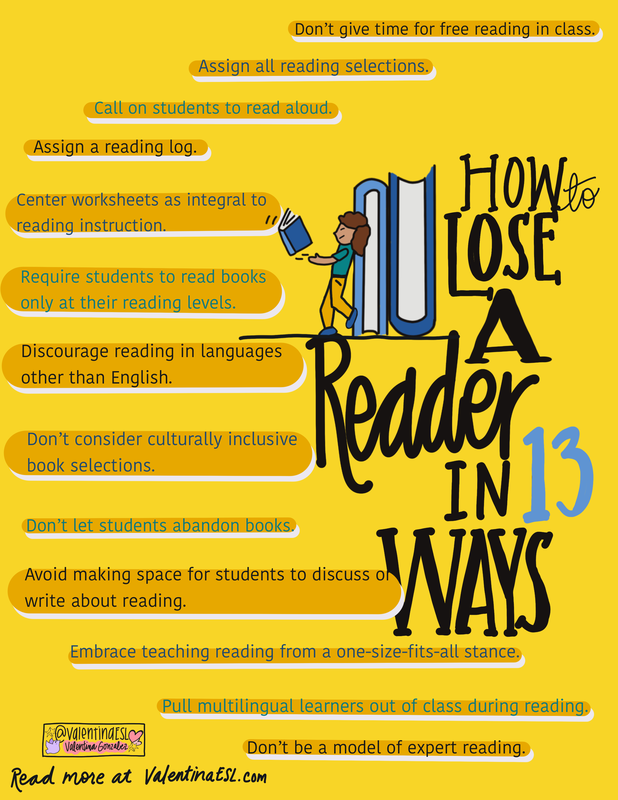
How to Lose a Reader (13 Ways)
Share
- Don't give students time for free reading in class.
- Assign all reading and offer students no choices in their reading selections.
- Be sure to call on students one at a time to read aloud in front of their peers, for example, popcorn reading or round-robin reading.
- Assign reading logs as homework and require students to fill them out regularly for a grade.
- Make reading worksheets a major practice of instruction and grading.
- Only let students read books at their reading levels.
- Discourage reading in languages other than English.
- Don't consider culturally inclusive book selections on your bookshelf and keep a blind eye to what students are reading.
- Don’t let students abandon books even if they aren’t connecting with them.
- Avoid making space for students to talk or write about their reading.
- Don’t meet students where they are as readers.
- Pull multilingual learners out of class during reading.
- Don't model reading by reading aloud to students or sharing your passion for reading.
This brief post lists 13 instructional practices that reduce the love and motivation for reading in students and then 13 ways to inspire and motivate them.
In contrast, here are 13 ways to help students find love, joy, and excitement in reading.
In contrast, here are 13 ways to help students find love, joy, and excitement in reading.
-
GIVE students planned, regular, intentional time for free reading in class. And plenty of it! It’s helpful to set goals and build stamina throughout the year.
-
Let students have a choice in their reading selection. Sometimes that means providing tons of books and free picking and other times it can look like a choice between a small selection of books on a topic we all need to learn about.
-
Avoid singling out, embarrassing students, or making reading about compliance. When kids feel on the spot about reading this increases the effective filter and can act against reading joy and motivation.
-
Create authentic opportunities for students to share what they are reading. Some classrooms participate in Speed Dating with books, buddy reading, book tastings, book trailers, etc.
-
Provide students with options for demonstrating reading growth. Examples might include portfolios, reading journals, reading buddies, podcasting, etc.
-
Raise the bar on reading and reduce the limits by letting students take more ownership of their reading.
-
Value all literacy and language by providing books in multiple languages. While this may be easier said than done, it is doable. Reach out to your school librarian, ESL department and other literacy specialists for support too.
-
Apply a critical eye to the books offered to students and assure that all students are experiencing connection and reading a wide variety of materials. Motivation for reading comes from reading relevant and compelling materials. What’s relevant and compelling to our students probably isn’t the same as what WE find relevant and compelling. Survey students and start building a bookshelf they will want to visit.
-
Teach students when and how to decide if a book is not meeting their needs. Just because we start a book doesn’t mean we must finish it and students need to know that reading is a two-way street. If the book doesn’t meet our needs, we move on.
-
Carve out time for students to write about and discuss the books they are reading. Most of the books I read come from a personal recommendation. That means a friend talked to me about it. Peers influence us in many ways. We can leverage peer pressure in our reading classrooms.
-
Know your students individually as people and as readers and move the needle from there. One-size-fits-no-one.
-
Reading is valuable for multilingual learners therefore keep them in the classroom during reading instruction, read-aloud, silent reading time, etc. In our book Reading & Writing with English Learners, Dr. Melinda Miller and I discuss the components of reading and writing and how to effectively scaffold instruction to meet their needs.
- Read-aloud to students no matter their age or the content area that you teach and talk with them about your own reading life.
